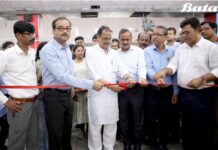Normal 0 false false false EN-US X-NONE X-NONE MicrosoftInternetExplorer4 st1\:*{behavior:url(#ieooui) } /* Style Definitions */ table.MsoNormalTable {mso-style-name:”Table Normal”; mso-tstyle-rowband-size:0; mso-tstyle-colband-size:0; mso-style-noshow:yes; mso-style-priority:99; mso-style-qformat:yes; mso-style-parent:””; mso-padding-alt:0cm 5.4pt 0cm 5.4pt; mso-para-margin:0cm; mso-para-margin-bottom:.0001pt; mso-pagination:widow-orphan; font-size:10.0pt; font-family:”Times New Roman”,”serif”;}
Federation of Karnataka Chambers of Commerce & Industry
STATE PRE-BUDGET MEMORANDUM – 2012 – 13
Mr. J.R. Bangera
President
Mr. K. Shiva Shanmugam
Sr.Vice-President
Mr. R. Shivakumar
Vice-President
Mr. N.S. Srinivasa Murthy
Imm.Past President
Mr. B.T. Manohar
Chairman, State Taxes Committee
Mr. L.S. Raghavendra Sharma
Co-Chairman, State Taxes Committee
Mr. A. Ramakrishna
Secretary General
Ms. Lillu Aswathiah
Jt. Secretary
Federation of Karnataka Chambers of Commerce & Industry
State Pre-Budget Memorandum
2012-13
PREFACE
Karnataka has always been at the forefront of industrial growth. It has provided an ideal choice for investment opportunities both from domestic and overseas investors. The Government needs to develop the State by improving infrastructure by moving at a fast pace on several mega infrastructure projects.
Initiation of stage wise e-governance in the Government Departments is a right step, supporting tax reforms and easing procedural aspects. Total e-governance is the need of the hour, to simplify tax laws and cut the cost of compliance. This budget should pave the way for a smooth shift to the GST regime.
After gathering the opinion and suggestions from our affiliated members of Trade, Industry, Service sector, Associations and Chambers of Commerce from all over the State, we put forth our suggestions for due consideration by the Government.
K. Shiva Shanmugam
Sr Vice President
February 21, 2012
Federation of Karnataka Chambers of Commerce & Industry
State Pre-Budget Memorandum – 2012-13
FKCCI is confident that the Government in this budget will make a renewed effort to simplify the procedural aspects of e-governance, improve business friendliness of State Tax Administration and improve compliance thereby increasing the revenue of the State.
The E initiatives introduced by many Departments are welcomed as they would reduce the interface between the Business and Government, however care needs to be taken to make these initiatives as dealer friendly as possible, for easy compliance and also to generate more revenue to the Government.
The proposed Karnataka’s budget has a special significance because this year is the first year of the 12th Five Year Plan. Hence, FKCCI feels that this budget should devise a well thought of road map for the Plan by taking appropriate development strategies and appropriate tax structure. Also, this budget can be evolved in such a way that it can be a guide for a smooth shift to the GST regime.
It won’t be out of place to present a brief review of the 11th Plan that ended with 2011-12.
Karnataka is one of the states which has a fairly good growth rate during the 4 year period of the 11th Plan, 2007-2011. As can be seen from Table-1, the GSDP of Karnataka at constant 2004-05 prices has registered a CAGR of 7.6% which is close to the CAGR of 7.9% India’s GDP in the five years of 11th Plan 2007-2012. It is also evident from the Table that growth, both in Karnataka and India, is largely propelled by the Services sector.
Table-1
|
Karnataka GSDP during 4 Years of 11th Plan ( At 2004-05 Prices) – Rs Lakhs |
|
|
|||
|
|
Agriculture |
|
|
|
|
|
|
Forestry & |
Mfg. |
Industry |
Services |
GSDP |
|
Year |
Fishing |
|
|
|
|
|
2007-08 |
3740508 |
4186928 |
7081551 |
11966968 |
22789027 |
|
2008-09 |
3805663 |
4566231 |
7324959 |
13054529 |
24185151 |
|
2009-10 |
3908729 |
4766943 |
7663756 |
13551922 |
25124407 |
|
2010-11 |
4138330 |
5232727 |
8227683 |
14769633 |
27135646 |
|
CAGR Karnataka |
5.5 |
7.4 |
6.5 |
8.8 |
7.6 |
|
CAGR India |
3.27 |
7.1 |
6.7 |
9.9 |
7.9 |
Note: 1. Industry includes: Manufacturing, Mining, Construction and
Electricity
2. CAGR – Compound Annual Growth Rate during the 4 years of
11th Plan
Source: Department of Economics & Statistics, GoK and CSO
The fact that the growth is mostly propelled by the Services sector is also evident from the fact that the reduction in the share of agriculture and allied sectors in State’s GSDP from 16.2% in 2007-08 (first year of the 11th Plan) to 15.3% in 2010-11 (the fourth year of 11th Plan) is largely made up by services whose share has increased from 53.1% to 55.2% during the same period. The share of manufacturing has almost been constant at about 18.5%. Even the share of total industry including mining, construction, manufacturing and electricity has been constant at around 30% during the 11th Plan (Table-2)
|
Table-2 Karnataka GSDP at 2004-05 Prices – % share in GSDP during 4 years of 11th Plan
|
||||
|
|
Agriculture |
|
Industry |
Services |
|
|
Forestry & |
Manufacturing |
|
|
|
Year |
Fishing |
|
|
|
|
2007-08 |
16.2 |
18.2 |
30.7 |
53.1 |
|
2008-09 |
15.7 |
17.8 |
29.0 |
55.3 |
|
2009-10 |
15.6 |
18.5 |
29.9 |
54.5 |
|
2010-11 |
15.3 |
18.7 |
29.6 |
55.2 |
Note: 1. Industry includes: Manufacturing, Mining, Construction and Electricity
Source: Department of Economics & Statistics, GoK
This is somewhat a disturbing point because the decline in the share of agriculture and the static position in the Industry in general and manufacturing in particular will also affect the creation of employment opportunities. Since these two sectors are major ones which would add to employment opportunities, there is a strong need that the 12th Plan policies should be evolved around the main aim of strengthening these two sectors. This year’s budget, thus, can play a major role for evolving the growth strategies.
Regional Disparities
It is important to note that despite outstanding performance of the Karnataka economy along with exceptional performance of industrial and service sector, the outcome in terms of regional distribution of income is not very encouraging. The distribution of income generated from industry and service sectors are largely concentrated in a few pockets of the state. Of the total income generated from Manufacturing in 2008-09, 59.6% is generated from Bangalore Urban and Rural alone. As can be seen from table-3, about 81% of the total manufactured income in Karnataka is generated only in 9 districts and the remaining 19% is from 21 districts. Similarly 66% of the income from services is also generated in 2008-09 from these 9 districts. Only in the case of agriculture and allied sectors, the reverse is true. (Table-3)
The un-Irrigated plateau zone of Northern Karnataka and that of central & southern Karnataka are the main lagging regions of the state and these must participate in the mainstream growth. Also, as pointed out in Karnataka Vision 2020, regional disparities is a significant challenge.As per Vision 2020 (Quoting Dr.Nanjundappa Committee’s report), of the 114 backward taluks in Karnataka (of total 175 taluks in Karnataka), 59 Taluks are located in North Karnataka and 26 taluks of the 59 ‘most backward’ taluks are also situated in North Karnataka. The growth can’t be inclusive unless it is well distributed across all districts.
Table-3
|
Share of District’s GDDP in State’s GSDP in 2008-09 at 2004-05 Prices (%) |
|
||||||
|
|
|
|
|
|
|
|
|
|
Sl. No |
District |
Agriculture & |
Mfg. |
Industry |
Services |
GDDP |
|
|
|
|
Allied |
|
|
|
|
|
|
1 |
Bangalore |
2.2 |
55.6 |
42.9 |
37.0 |
34.1 |
|
|
2 |
Bangalore Rural |
1.5 |
4.0 |
2.9 |
1.9 |
2.1 |
|
|
|
Total Bangalore |
3.7 |
59.6 |
45.8 |
38.9 |
36.2 |
|
|
3 |
Belgaum |
8.4 |
5.0 |
5.2 |
4.8 |
5.4 |
|
|
4 |
Dakshina Kannada |
3.6 |
4.4 |
4.7 |
5.9 |
5.4 |
|
|
5 |
Mysore |
4.0 |
3.5 |
4.0 |
5.0 |
4.6 |
|
|
6 |
Bellary |
3.1 |
2.1 |
5.2 |
4.4 |
4.4 |
|
|
7 |
Tumkur |
6.1 |
2.2 |
2.8 |
2.8 |
3.2 |
|
|
8 |
Gulbarga |
5.0 |
1.4 |
2.7 |
3.3 |
3.4 |
|
|
9 |
Dharwad |
2.2 |
2.7 |
3.0 |
3.3 |
3.1 |
|
|
Sub-Total 9 Districts |
36.1 |
80.9 |
73.4 |
68.4 |
65.6 |
||
|
Rest of Karnataka 21 Dists |
63.9 |
19.1 |
26.6 |
31.6 |
34.4 |
||
|
|
Total Karnataka |
100.0 |
100.0 |
100 |
100 |
100 |
|
The growth process generating inequitable distribution of income across the state is not desirable outcome as far as welfare of the people is concerned. It is against the future of economic growth as well as the vision of the state that seeks for …….eliminating of poverty and deprivation at all levels and …promoting equitable growth covering all sections of people and regions of the State (Karnataka Vision for Development – 2008; page 18).
The absence of the growth opportunities in socio-demographic and economically vulnerable regions has far deep implications for welfare of the State since it perpetuates more economic backwardness and social structure dominated by caste and class characteristics.
Though industrial and service sectors have shown outstanding growth performance in the state, their success still has limited appeal for: a) large mass of population and b) for sustainable and inclusive growth character of State economy
Suggestions
In this scenario, the strategy should proactively focus upon growth concerns of agriculture and Industrial sectors, which would yield maximum welfare benefits to State. The economic growth to be sustainable and socially acceptable, it must assure benefits to all quarters of society. These two sectors provide maximum possibility of the above. In current market-cum-state framework, the benefits of economic growth are anticipated through trickled down mechanism and active state policies promoting growth process that are inclusive. In the development efforts of the State, agriculture and industrial sectors still has significant roles to play. The promotion of agro-based industries and small scale industries in socio-economically vulnerable and backward districts would be effective strategies towards achieving inclusive and sustainable growth.
INFRASTRUCTURE
World-class infrastructure is the key to faster development of Karnataka’s economy. Good road and rail network is the fundamental requirement for rapid growth of Trade & Industry, Tourism and overall development of Karnataka, as it provides connectivity to remote areas and access to markets, besides opening up backward regions to trade and investments.
RAIL-ROAD CONNECTIVITY
Government has envisaged in its Vision Document of Karnataka 2020 to tap the entire potential available throughout the State for development of existing 15,000 KMs of State Highways for easy access from one District Center to another as well as Taluk Centers and provide easy mobility and smooth access to the remote State Border Areas under State Highways Development Projects (SHDP). Fresh initiatives have been taken to mobilize funds to the tune of Rs. 13,363 crores under Public-Private Participation (PPP), Leveraging, Toll Revenue Departments, Budgetary Resources and also funds from External Resources. This together with Rail-Road connectivity will give the much needed boost for rural prosperity.
This initiative in bringing all areas in the State connected would bring a manufacturing revolution in rural areas by encouraging the entrepreneurs to set up Industrial Corridors on the connecting roads. It will help particularly, Medium, Small and Micro Industrial Areas which in turn could help in reducing migration to urban areas by providing employment in respective rural areas.
One of the main reasons for low price realisation by the farmer for his produce is the lack of connectivity to the markets and consumer places, which in fact is the major requirement in building up a proper supply-chain. Improving connectivity would help in reducing income disparities to a great extent & also help boosting exports.
There is another factor that brings urgency to this task of building road connectivity and also to strengthen the existing roads. Our industry and trade are losing their competitive advantage because of the limited carrying capacity of our roads. Bad roads are not only unsafe, but they also result in unacceptable levels of wear and tear, and waste of energy.
Keeping the above in mind, FKCCI urges the Karnataka Government to give significant importance to this sector in the ensuing budget. Some of the major suggestions are listed below.
Shiradi to Mangalore Road
Ghat portion from Shiradi to Mangalore Port, a stretch of about 27 kms road is without surface. In fact, basic road does not exist there. Surface of the road is torn and worn-out and is in such a bad shape that it is not motorable and poses danger to vehicles and passengers. Most important fact is that this road also hinders movement of container traffic to New Mangalore Port. Being the main source of connectivity from State Capital and Mangalore, the only outlet major port in Karnataka, this bad stretch has become a nightmare for the export traffic to Mangalore and is adding to unnecessary costs.
In order to make the movement of goods smooth and faster, it is very pertinent that the Government should evolve a proper plan/design for road in this section, so also elsewhere, approved by the competent authority or expert in road building and execute the work with proper supervision to ensure quality and capacity to withstand heavy vehicular traffic. FKCCI urges that separate funds should be earmarked for this important project.
It is understood that about 3,714 km of roads across 189 rural Assembly constituencies in the State, @ 20 Kms per constituency, had been developed in the first phase of Namma Grama Namma Raste during 2011-12 and another 30 Kms of roads per constituency would be developed during the next two years. This indeed would be a significant beginning to the 12th Plan and should be accelerated to 40 Kms per constituency very soon so that by the middle of 12th Plan all villages in Karnataka are connected by roads.
Development of NH 17, NH 48 and NH 13
There is an urgent need to upgrade and develop the important NH 17, 48 and 13 which are connected to Port facilitating the hinterland development. The State Highways are to be developed and the roads connecting inter-State are to be 2 laned for speedy movement.
Express Highways
For facilitating the fast developing industry and trade, express highways play a major role. One of the factors that made China a manufacturing-hub today is the huge 85000 KMs expressways it built in about 23 years.
The Union Road Transport and Highway Ministry plans to set up a network of 18,000 km Greenfield expressways across the country by 2022. Karnataka Government can take an active lead in this programme. The proposed Chennai-Bangalore expressway with the help of Japan could be an example.
For becoming a leading industrial hub in the country as also to become the leading economic state in the Country, Karnataka Government has to speed up its plans for better connectivity between major industrial hubs and the ports. This budget could be the beginner for this major programme.
PORTS
Tadri Port
There is a good scope to develop this port with modern infrastructural facilities. Konkan – Railway line and N.H.17 are passing very close to the port area. Also N.H.63 and proposed Hubli – Ankola Railway line and Honnavar Tumkur N.H. 206 are added infrastructural facilities for all-round development of Tadri port. This port has been projected for development under BOOST (Build-Own-Operate-Share and Transfer) concept through private participation. Vast area is available for development of this port with negligible rehabilitation problems. Tadri port has got an effective hinterland of about 2.00 lakhs Sq.Mts. comprising of Central and Northern parts of Karnataka and some parts of Andhra Pradesh, which are rich in large deposits of minerals, forests, agricultural and marine wealth.
In view of the above, FKCCI urges the Government to make special efforts to build this port at a faster pace than is being done now.
We also urge the Government to develop all other minor ports so that the exports from Karnataka can be expanded to achieve a high US $ 100 billion by the end of 12th Plan.
RAILWAY LINES
Further to improve the rail infrastructure for speedy and economical movement of the goods, we request the Government to take up the following projects, for immediate action, with Railway Ministry:
Hubli – Ankola Railway line
This line, which is in planning for many years now, should be taken up at an express speed.
- Electrification of Bangalore-Tumkur, Bangalore-Mysore
- Doubling of track between Tumkur-Arsikere
To speed up the following works:
- Almatti-Koppal, Bagalkot-kuduchi, Bidar-Gulbarga, Bangalore-Hassan
- To approve the link between Chamrajnagar-Mettupalya,Tumkur to Davangere via durga
- To build a 2nd platform at Tumkur
- Under the dedicated corridor North to South, Karnataka is to be included.
- To provide high speed passenger rail corridor: Mumbai-Belgaum-Bangalore-Chennai
POWER
Low power availability would hamper the industrial growth. Efforts should be initiated in this budget, by way of new incentives, for increasing power generation through the “Renewable Energy Route” as is being done in Gujarat.
Subsidy for Irrigation Pump Sets consumptions (IP Sets)
The subsidy allocation for IP Set consumption is inadequate since the estimated consumption is around 12,600 million units and at the present average cost of Rs.4.50 the requirement would be Rs.5,670 crores. However Honble Commission has determined a tariff of Rs.1.21 p per unit which is not even meeting the Power purchase cost.In view of the provisions of Tariff Policy the Cross Subsidy component for any class of Consumers should be within + – 20% of cost of supply. Therefore the cross subsidies will be brought down to reach this mandate progressively by successive tariffs. Hence additional allocation of funds are to be ensured.
Losses on account of inefficient pumpsets which is estimated at 18 lakhs, is a highly exaggerated number & not in agreement with the census conducted by Minor Irrigation Department which works out to 11-12 lakh IP sets only. Not withstanding this anomaly, it is suggested that an external agency be invited to replace all the irrigation pumpsets with an assurance that a certain percentage of saved energy will be allowed to be claimed as deemed generation. This will largely bring down IP set consumption and make the saved energy available for other productive purposes. It is estimated that efficiency of the existing IP sets is around 40% only.
Further, it is suggested that a policy direction from the State Government be issued under Section 108 of Electricity Act 2003 exempting payment of electricity charges by the irrigation pumpsets for a period of 10 years subject to these installations accepting to install metering. At the moment the entire attributed consumption of 12600 MU is only estimation and is causing a heavy burden on the States exchequer.
ADDITIONAL GENERATING CAPACITY
In addition to the major Thermal plants coming up in Kudgi in North Karnataka, small capacity Solar, Wind, Biomass hybrid versions of Power generation are to be started in every District of the State, with minimum of 4-5 mega watt capacity, to augment the needs of Water in Hospitals and Educational Institutions.
INDUSTRY
For the overall, well balanced and inclusive development of Karnataka, development of industry has to take a major role in the ensuing 12th Plan. As mentioned in the beginning, there is an element of regional disparity in the growth of Karnataka. This is evident in the case of Industry as well.
When we look at the regional spread of industrial units and employment provided by them, the picture appears to be grim (Table 4). They are largely concentrated in the same districts that are mentioned above. What makes this unique feature of industrialization and economic growth in the state is creation of central growth poles concentrated in a few regions. What one may call this is realization of backwash effect in Karnataka economy growth dynamics. Wealth and labour move from poorer, peripheral areas to more central regions of economic growth and the industrial production of wealthy regions may well undercut the industrial output of the poorer regions. This draining of wealth and labour together with industrial decline is the backwash, or polarization effect. The out migration trends from the poorer regions of State to relatively developed one explains much of this phenomenon.
Table-4
Regional Concentration of the Industrial Units and Employment
|
|
Percentage Share of Each District |
|||
|
Factory Units |
Emp-loyment in factory Units |
SSI Units |
Emp-loyment in SSI Units |
|
|
BANGALORE |
50.59 |
57.41 |
17.1 |
27.2 |
|
BANGALORE(R) |
3.31 |
5.47 |
4.3 |
4 |
|
Total Bangalore |
53.9 |
62.88 |
21.4 |
31.2 |
|
BELGAUM |
5.51 |
5.18 |
8.5 |
6.3 |
|
DAKSHINA KANNADA |
4.26 |
3.32 |
5.1 |
4.5 |
|
MYSORE |
4.75 |
4.41 |
5.8 |
5.2 |
|
BELLARY |
3.16 |
3.11 |
4 |
3.4 |
|
TUMKUR |
2.89 |
2.12 |
5.5 |
5 |
|
GULBARGA |
0.83 |
1.11 |
4.1 |
3 |
|
DHARWAD |
4.17 |
2.2 |
4.2 |
6.1 |
|
Sub-Total |
79.47 |
84.33 |
58.6 |
64.7 |
|
9 Districts |
|
|
|
|
|
Rest of Karnataka |
20.53 |
15.67 |
41.4 |
35.3 |
|
21 Districts |
|
|
|
|
Source: Karnataka at Glance, 2009-10, GoK
This budget should make a beginning to change this scene. Development of the MSME, in the districts and places that have low industry spread, would be major step in this direction. Food processing industry can play a significant role in this effort. This budget can initiate action by providing the required support and incentives for the development in the areas that are neglected so far. Special schemes can also be evolved.
Taxes on Industrial inputs and consumer Goods.
The industrial sector is presently undergoing a slowdown in the country. The overall industrial production in the country during the first 9 months, April-December of 2011-12, has been much lower at 3.6% as compared to 8.3% during the same period in the previous year. Manufacturing sector also has a much lower growth of 3.9% as against 9% in previous year during the same period.
Falling domestic demand. Due higher prices, is one of the reasons for this. In view of this, FKCCI urges the State Government to reduce the VAT rates on all industrial and consumer products.
BOOSTING INVESTMENT
This slowing down has also adversely affected the investment environment. Boosting investment in the present scenario, marred by uncertain economic outlook, called for an aggressive policy stance, introducing investment allowance, fast-tracking implementation of projects, providing boost to investment in infrastructure, simplifying tax and regulatory compliance.
LAND
In the development of infrastructure and industry, land is going to be an increasingly major hurdle. The recent problem in acquiring land for the proposed POSCO plant is point in this direction. Government should initiate process to strengthen the land bank, preferably the non-arable lands. This budget should look into this aspect urgently because this would impact the ensuing GIM in June 2012.
TOURISM
Tourism, as an industry has gained importance in the last decade. Tourism is a sun-rise industry which has huge potential to bring in economic and social changes. There are nations who thrive on tourism alone. It generates local employment and valuable foreign exchange to the government. Further, we need to show the world that Karnataka in particular, has world class tourist destinations with bounty of nature, archeological monuments, historical places and so on.
Karnataka is one state, many worlds with its mix of rural tourism, medical tourism, heritage tourism, adventure tourism, coastal tourism, heli tourism, entertainment, etc. Karnataka currently (2010) Ranks 5th for domestic tourist with 38 million domestic arrivals and 11th for foreign tourist with 0.38 million of international arrivals. FKCCI is happy to note that the State Government recognizes tourism as a major growth engine.
Our state has tremendous potential to improve its ranking very soon. Government should take the following steps for achieving this goal.
- Augmenting staff strength of Dept of Tourism at major tourist destinations.
- Establishment of information kiosks at Railway Stations/Bus Stands
- Organising Festivals in all regions, tourist centres, in line with Hampi Festival.
- Construction of yatrinivas, dormitories and guest houses at tourist destinations.
- Botanical Garden at Harangi dam.
· Development of Basavakalyan, Narasimha Zarna (Bidar Dist), Yana, Magodu Falls (in UK dist), Kandagiri (Chikkaballapur dist), hill ranges in Chamarajanagar, Alamatti (bidar dist) and various tourist spots at Davangere district
STATE TAXES
FKCCI has been repeatedly expressing its view that the State Budget should announce measures that pave the way for Economic Revival and implement schemes that provide impetus for Economic activity.
We do hope that in this budget the Government will consider reverting back to the VAT rate which was enhanced from 4 to 5% and 12.5 to 13.5% & last year to 14%, which will greatly help the common man, support the business and prevent trade diversion.
Continuation of exemption on Food Grains, Pulses & Wheat Products.
The Govt. of Karnataka vide notification No.FD 35 CSL, 11 dated:29-3-2011, had exempted the following commodities from VAT Tax, for a period of one year ending 31st March 2012,which should be extended for 1 more year.
1. Paddy & Rice
2. Wheat
3. Pulses
4. Flour and soji of rice and wheat
5. Maida of wheat.
Sales Tax on Petrol and Diesel:
The rate of tax on Petrol and Diesel is high when compared to Maharashtra and Andhra Pradesh States. This disparity in rates of taxes has resulted in diversion of trade to neighbouring states. Therefore the rate of taxes should be at par with neighbouring states. This will result in additional revenue to the Government.
Widening of Taxbase
There are many unregistered dealers who are causing unhealthy competition in the market. Therefore, an extensive, proper & systematic survey be conducted by the department to rope in potential unregistered dealers and widen the tax base.Further, VAT awareness programme is essential to lure such dealers for voluntary registration and also such dealers should not be heavily penalized if they approach the department voluntarily.
Modernisation of Checkposts-Further, the checkposts should be modernised and the documents collected at the Checkposts should be cross-checked regularly in order to prevent revenue loss to the Govt.
These measures will enable the Govt. to increase the revenue and also promote healthy trade practices in the trade and industry.
Reforms
- Make registration procedure very simple and timebound.
- Introduce total automation of Commercial Tax Department with sufficient updated infrastructure.
- To provide a Help-desk manned by technically and professionally trained personnel which should work 24/7 in all offices of the department throughout the State.
- Public Awareness Programme for social responsibility towards payment of taxes and obligation of dealers to be carried out.
- To conduct Orientation Programme for officials in the department on Law/ Procedures and to be made accountable.
- To update information on Commercial Tax Website regarding Acts/Rules/Notification/Clarification under all Acts of Commercial Taxes.
- VAT Advisory Board to be made functional and meet quarterly.
- To ensure preparedness of the department for GST.
- To reduce tax on motor vehicles so as to avoid people buying vehicles from neighbouring States such as Tamil Nadu, Kerala, Pondicherry, where Sales Tax is much lower than in Karnataka.
- To increase the staff strength in the Commercial Tax Dept. as insufficient staff especially Commercial Tax Inspectors is creating difficulties to the dealers.
- To reduce tax and make the cost of petrol and diesel on par with neighbouring States especially in the borders of our State.
- Divisionwise Commercial Tax Consultative Committees to meet quarterly.
- To explain determination of Total turnover – Sec.2 (35) Total turnover. The words “turnover of purchase or sale in the course of inter-state Trade or Commerce to be explained.
- Sec.27(1)(e) to provide proviso for an opportunity of being heard. – Reason for amendment to be provided in Form VAT 1.
- Sec.40 (b) to be deleted.
- Sec.53 (12) – No penalty to be levied if e-sugam is generated at the time of vehicle leaving the checkpost.
- Sec.72 (1)(b) penalty – 1% of tax or Rs.500 whichever is lower if the default is not more than 10 days, 1% of tax or Rs.1,000 if the default is more than 10 days.
E payment-All scheduled banks should be enabled for E payment and the Department to accept Tax payments through RTGS/NEFT as it is difficult for the Dealers to operate Current Accounts in the Banks notified by the Government. Till then the Scheme may be optional.
MSEs-Due to cash crunch faced by Micro and Small Enterprises (MSEs) on account of delay in receipt of payments from their customers, it is requested to allow MSEs to make e-payments once in a quarter, though the e-filing is done every month.
Deduction of tax at source Under Section 9-A requires to be made more effective:
A large part of construction activity is also under taken for entities who are non dealers such as Charitable & Educational institutions. Commissioner has not yet notified u/s. 9-A (1) such entities to deduct tax at source in respect of any Works Contract executed for them.
COMPOSITION TAX paid by Works Contractors u/s.15(1)(b) and u/s 15(5)(a) , be made eligible for Input Credit:
W.e.f. 01.04.2006, under Rule 139(3) Works Contractors are permitted to collect composition taxes. Consequential amendment to section 10(4) is not made to include the word “bill of sale” after the words “a Tax Invoice…..”.
This prevents contractee/employer in claiming Input Credit of taxes collected by Works Contractors under composition scheme for end user dealer (contractee). This is a major set back in turnkey projects.
For Dealers Executing Works Contracts in Composition Scheme:
For Dealers covered under Section 15(1)(b), presently there is no provision in section 15 with respect to:
(a)To deduct value of Sales returns from turnover (returned within 6 months from date of sale) and to return the taxes (if any collected) as credit note cannot be issued by composition dealer.
(b) To carry forward to subsequent tax period, deduction in excess of turnover related to payments to sub contractors (Section 15(5)(b)). This is typical to flat developers, who cannot book the turnover as buyers are few initially.
Section 15(5)(a) requires more clarity:
i) There is a need for clarity in respect of taxability of capital goods brought from outside the state, which are used in the works but are not passed on in executing of works. Presently, our state is losing revenue in respect of such goods as value of such goods are not offered to tax u/s. 15(5)(a).
ii) Providing deduction of sale value of goods on goods brought from outside the state, from turnover liable to composition, whereas purchases within the State is at disadvantageous position, as there is no deduction from turnover for such local purchases.
iii) The rate of tax applicable u/s. 15(5)(a), it is not clear as to whether the rate is as specified in section 4(1)(a)/4(1)(b) or 4(1)(c).
A works contractor under composition scheme has to pay tax at regular rate for purchase of taxable goods made from URDs as per Sec 15 (5) (e) in addition to paying tax on total contract receipt. If the same contractor purchases taxable goods from outside the state, the purchase value has to be deducted from the contract receipt of that month and the balance receipt is liable to tax at composition rate and the purchase made from outside the state is liable to tax as prescribed u/s 4 of the Act. The reason is that the purchase made has not suffered local tax at regular rate. The same method may be followed in respect of purchases made from URDs inside the state. Otherwise it will result in double taxation.
Making Best use of TINXSYS software in interstate trade:-
i) At present, the data of interstate movement is monitored in TINXSYS software across India. As lot of discrepancies take place in interstate trade causing revenue leakages to states, it is fair enough to make best use of this software, by enabling dealers to get information of transactions taking place in their respective TIN number. For E.g.: Goods originating from West Bengal, destination Name & TIN shown as Karnataka but unloaded and sold in Andhra
Pradesh. If all dealers are having access to TINXSYS information about transactions pertaining to them, such malpractices can be prevented and revenue loss can be plugged.
ii) Presently, other states have also made it mandatory to upload details of inter state movements in their website. This leads to duplication of Work, as both seller/buyer has to upload in their respective States. Instead, if this uploading is carried out in TINXSYS platform, a single uploading either by buyer/seller will comply with the requirement of both the states simultaneously.
Rectification of mistakes under Section 69:-
As per Section 38(1) all returns are deemed assessments. Whenever any judicial pronouncement favourable to dealer is pronounced, at present there is no scope for applying for rectification from dealers end. Therefore Section 69(2-a), be suitably amended to accommodate specific rectification of any mistake in a return, as being apparent from record.
Input tax restricted goods should not be subjected to tax again unless there is value addition:-
In respect of Input Tax restricted goods (section 11(3)) enumerated in Fifth Schedule of KVAT Act, 2003, especially goods covered under entry 1, 3, 4 & 5 when sold by dealers in subsequent years after usage, should not be subjected to Net Tax unless there is value addition over & above purchase value. As VAT is fully realized in respect of such goods initially and normally these goods are depreciable in nature fetching lesser value than cost, subjecting them again to net tax is unfair as there is no value addition at all.
For Example: Notification No. FD 115 CSL 2007(4), Bangalore dt.30.03.2007 subjecting used motor vehicles when sold to 5% net tax.
In case of hoteliers opting For Composition Scheme U/s.15(1)(C):
i) Presently hoteliers opting for Composition u/s.15(1)(c) are not permitted to purchase goods for use in sale from outside the state. This puts them at disadvantageous position as to buying quality goods & price advantages. This anomaly to be set right by bringing them at par with Works Contractors u/s.15(5)(a).
ii) Composition Scheme be extended to hotels serving liquor
Hotels serving liquor should be permitted to opt for composition, as liquor sales are outside the purview of taxation under KVAT.
Specific points For SEZ Unit/Developers:
- KVAT for entire area including Non Processing Area of Special Economic Zone be exempted instead of the present exemption by way of Refund route for processing area alone.
- Refund of KVAT should be expedited.
- Exemption for petroleum products for Special Economic Zone in KST be considered.
- Entry Tax should be exempted for petroleum products for Special Economic Zone.
5. Accord deemed export status to supply of goods to SEZ UNITS/ developers of SEZ’S in the State:
Supply to above dealers is Zero rated in interstate trade under CST Act, 1956. Whereas in KVAT Act 2003, tax has to be charged by suppliers and units of SEZ has to go for refund route of tax paid u/s.20(2), as refunds are not forthcoming or prolonged for a very long time.
- Declare the entire MSEZ and MRPL area as Industrial Township and single local area under KTEG Act, 1979.
- Increasing the exemption of Stamp Duty and Registration Fees to 100% in respect of the SEZ units.
Revision of Returns
Under the present law, returns are to be revised within a period of 6 month from the end of the relevant Tax period. The Commissioner circular specifies that if the return is filed belatedly and there is any tax payable by the dealer, then such revised returns above six months is acceptable by the dealer.No VAT/CR-31/2008-09 dtd 7.7.2008
Suggestion:
We suggest that the time limit for the revision of the original return should be increased to nine months from the end of the financial year.
The law should not penalize the dealers when they have filed the revised returns within reasonable time. The dealer should be allowed to file the revised return above six months even though there is input tax credit which is yet to be claimed by the dealer. Even for dealers like works contractor, wherein the extended time for filing the revised returns due to many factors involved in execution of such contracts, should be provided.
Audit
The law states that the audited statement of accounts shall be submitted in Form VAT 240 to the Jurisdictional Local VAT officer or VAT sub officer within 9 months after the end of the relevant year.
Suggestions
We suggest that the Form VAT 240(Format of Audit report) should be separately drafted for composition dealer and KVAT dealer so that it will be convenient to the department and the auditor to extract the required information like monthly return (Form VAT 100/Form VAT 120). No departmental Audit be conducted by the VAT Authority, if Form VAT 240 (Audit Certificate) is filed.
Audit under different Acts-It may be noted that, the audit is taken up separately by different officers at different point of time under different Acts – VAT, KTEG & CST Act. This takes lot of time of the assessee, as well as the department. Further, the department can also
take a comprehensive look on finalizing the audit, if the audit is covered under all the acts at one time with one officer.
Introduction of jurisdictional and pecuniary limits for Audit Officers:
Under the present law there are no jurisdictional and pecuniary limits for Audit Officer. This is causing inconvenience to the trading and business community. Therefore, it is suggested that precise pecuniary and jurisdictional limits may be prescribed for Audit Officers for effective implementation of the Act. This system was erstwhile in Karnataka Sales Tax Act.
Concessional Rate-For all Karnataka Government and State Public Sector tenders, where there is last point of consumption, the dealers of Karnataka State should be allowed to charge VAT equivalent to CST to create level playing field with respect to bordering states, who are enjoying concessional rate of tax (CST) when compared to KVAT.
ADMINISTRATION
E Sugam to be further strengthened:-
Presently, this system does not reveal information to the other party (other than who uploaded data) about transactions (purchase or sale) made by using his TIN number.
If the E Sugam software is upgraded to enable the dealers to obtain summary of information of E Sugam movements taken place in their name (as purchaser/seller etc), the entire system can be made fool proof.
Clarification U/s. 59(4) by Commissioner to be made time bound:
Applications made to the Commissioner are not disposed expeditiously. It is therefore suggested that time limit be fixed within which the Commissioner has to clarify. This process should be subjected to reasonable time frame of say fifteen days.
Check posts to have weighing bridges:
The transporter faces lot of inconvenience due to lack of this facility at check posts. Also our state is losing revenue, wherever unaccounted over loading gets unnoticed due to lack of weigh bridges.
Returns-In VAT-100 and 120, the returns are titled as original / revised / corrected / final. Sec. 35 (1) prescribes for filing of original return. Sec. 35 (4) prescribes for filing of revised return. Sec. 27 (4) read with rule 42 prescribes for filing of final return. But there is no mention in the Act or rules about the circumstances under which a ‘ Corrected ’ return could be filed.
In the recent amendment to the KVAT Rules, Form VAT-100 has been amended to prescribe Non deductible input tax in respect of purchase returns made in the month. There is some problem in furnishing the information when the input tax in the purchase return is more than the input on the purchases made in that month. The computer will not take negative value of input tax.
At present sales return is being shown box 2.1 of VAT-100 including out put tax. The dealers are facing problem in deduction under appropriate tax rate turnover and tax. There is also some difficulty in furnishing the information when the sales return turnover and output tax in sales return are more than the actual sales and out put tax in that month.
Refunds are not forthcoming as per Rule 128:
i) Wherever refunds are claimed as due by dealers in monthly returns, the LVO/VSO’s are neither issuing refund orders nor rejecting it under Rule 128(3). This leaves the dealers in peculiar situation of indefinite waiting for refund, without genuine reasons for delay. This leads to indiscipline in tax management, shaking the confidence of tax paying community as the law cannot be different for Government & Dealer in payment/refund. In order to ensure discipline in refunds, Rule 128 should be strictly implemented.
ii) Adjustments of Refunds:
The tax paid on account of order u/s.39(1) or on confirming orders by Appellate authorities which are finally refundable on account of orders passed by competent authority or Court, dealer should be given option to adjust for current demands by issue of proper orders in Form-250 by the LVO’s. At present there is scope for adjustment towards arrears only. This requires proper amendments in Rule 129(2).
SMR authorities to camp at Mangalore Hq:
Department is taking up sou moto revisions who have Head Quarters at Bangalore. The dealer has to travel to Bangalore to participate in proceedings. When the amount is small, the cost of participation is more and many times dealers abandon the proceedings on cost consideration. The suo moto revisional authorities may be directed to hold camp periodically at Mangalore Head Quarters in such cases.
Notice before creating demand for Non Filing Statutory Forms:
As per Amendment to the CST Act there is obligation to file ‘C’ Forms within next quarter. Failure to file ‘C’ Forms will result in deemed assessment and concerned LVO are issuing demand notice in Form VAT 210. An opportunity be given to file the ‘C’ Forms before issue of form VAT 210, so that appeal proceedings may be reduced.
Cancellation of registration & returns of NSC/Security Deposit:
Whenever application for cancellation of registrations are made on discontinuation of business, no certificate of cancellation of RC are issued and refund of NSC’s pledged/security deposit are carried out by the LVO’s so as to make the finality of closure proceedings. A time stipulation may be made to issue cancellation certificate and return of NSC pledged/security deposit.
Setting time limit for conclusion of Reassessment proceedings after issue of notice of proposition.
1. Dealers have option to move from VAT to COT or vice versa. Whenever such changes are done, revised returns pertaining to the earlier period are not permitted in the system. Due provision be made for revised returns in the e-filing system.
Dependency of Rate of tax on Central Excise Classification:
Notifications are issued for information technology products, capital goods to reduce the rate of VAT to 5%. The items specified in the notifications have been given in reference to their classification under Central Excise. It is suggested that the Changes in the Central Excise Tariff should be immediately incorporated in the State Law also otherwise the product rate will be disputed.
ENTRY TAX
- Sec.17(A) proviso for retention of books of account – years to be specified.
- Sec.5 (6) notification for acceptance of returns for the period 2006-07 & 2007-08 to be issued as the period is timebound.
Petrol, Diesel, Oil & Lubricants-Petrol, Diesel, Oil & Lubricants are subjected to Entry Tax of 5%. These commodities are not subjected to Entry Tax in neighbouring states of Maharashtra, Andhra Pradesh and southern states resulting in disparity in the rates of taxes, which in turn causes diversion of trade.Therefore, it is requested that, Entry Tax on these commodities be removed.
Sugar– To be exempted from Entry Tax or reduced to 1/2 %
Textile– To be exempted from Entry Tax
Cutting Tools– To be exempted from Entry Tax
MOTOR VEHICLE TAX:
The existing system of Road Tax on vehicles is as follows:-
Vehicle Cost (Rs.) Total
Upto 4,99,999 14.43%
5,00,000 to 9,99,999 15.54%
10,00,000 to 19,99,999 18.87%
20,00,000 and above 19.98%
Due to lower rates prevailing in neighbouring states of Kerala, Pondichery etc, the higher end new vehicle purchases and registration is taking place there and besides vehicle tax our state is loosing 14% KVAT on vehicle sales also. Hence rates adopted by neighbouring states be followed to prevent trade diversion.
PROFESSION TAX – Age limit for Profession Tax
- Presently the age limit for Senior Citizens under this Act is 65 years which should be reduced to 60 years as done under the Income-tax Act.
- It is suggested to increase the turnover limit for determining the Profession Tax payable by dealers registered under the Act as below:
Upto Rs.5 lakhs .. Nil
Above Rs.5 lakhs & upto Rs.25 lakhs .. Rs.1,000
Above Rs.25 lakhs & upto Rs.50 lakhs .. Rs.1,500
Above Rs.50 lakhs .. Rs.2,500
- Thresh hold limit of Professional Tax for salaried persons to be raised to Rs.15000.
STAMP DUTIES
- Stamp duty leviable on purchase of property is too high leading to under valuation. If the stamp duty is lowered there will be better compliance.
- Stamp duty for registration of partnership deed should be brought down to Rs.100 from the present duty of Rs.1,000. For change in constitution the documents should attract stamp duty of Rs.100 only.
APMC
- The APMC Cess to be reduced from 1.5% to 0.5 %.
- Payment of APMC Cess to be extended to one month instead of weekly payments.
Members Suggestions
Rate of Taxes
|
Commodity/Industry |
Suggestion |
|
Powder Refractories |
Bricks attract 5% KVAT where as powder refractories attract a KVAT of 14.5%.It is requested to bring down the KVAT rate for powder refractories also to 5%. |
|
Fabricated Structural Steel |
To fix a concessional rate of sale tax of 2 per cent upon sale of Fabricated Structural Steel as a product Or Consider the products of Fabricated Steel Structural as a capital goods and thereby fix the rate of KVAT at the rate of 5 per cent
|
|
Wheat & Wheat Products |
VAT exemption may be extended for the period 2012-13 also.
|
|
Pulses & Food Grains |
KVAT exemption on Pulses, Food Grains, Wheat & Wheat Products, & other Essential Flour Items should be continued. |
|
Gold jewellery/silver articles/medallions |
Kvat on gold jewellery/silver articles/medallions increased to 2% last year to be reduced to 1%.
|
|
Paint Brushes |
The rate of tax on paint brushes to be brought down from 14% to 5% as most other states charge 4 to 5%.
|
|
Supplies made to Central & State Government Departments / Boards / Corporations and undertakings |
Taxes should be exempted or brought to 4% only,so that parity will be maintained throughout the Country |
|
Hotels |
|
|
Oil Seeds & Oil cake and cotton seeds |
To be reduced to 2% & make CST 2 % to avoid refunds
|
|
Paper envelopes and student Note Books |
To be exempted from KVAT
|
|
Office files made of paper boards |
Should be included in the entry of Paper & Paper Boards.
|
|
Pooja Articles |
Which are presently taxed at 13% to be exempted
|
|
Mosquito Nets & Repellents
|
To be exempted
|
|
Dry fruits |
The rate of tax to be reduced from 14% to 5%
|
|
Bicycles, Tricycles, Parts, accessories, tyres and tubes |
To be exempted |
|
Electrical goods |
To be reduced from 14% to 5%
|
|
Petrol & Diesel |
Sales Tax to be reduced on par with the neighbouring States
|
|
Footwear |
Costing less than Rs.500/- to be exempted
|
|
Rolling shutters |
Presently charged at 14% to be reduced to 5%
|
|
Fried Gram |
Presently taxed at 5% to be exempted
|
|
Glassware and crockery |
To be reduced from 14% to 5%
|
|
Aluminium utensils |
To be exempted
|
|
Earthern roofing tiles (clay) |
To be reduced from 14% to 5% |
|
ERW steel pipes and tubes, electrical conduit metal |
To be included in the 3rd schedule of KVAT Act |
|
Madeups (towels, bedsheets and shoddy blankets) |
Rate of tax to be brought in par with neighboring States |
|
Tamarind |
Presently taxed at 2% to be exempted
|
|
Red Chillies |
To be exempted
|
|
Dhanya |
To be reduced from 5% to 2%
|
|
Water Supply Valves |
Presently taxed at 14% to be reduced to 5%
|
|
Sweet Supari |
To be reduced from 14% to 5%
|
|
Chapattis |
Presently taxed at 14% to be exempted
|
|
Bulk Chemical products like Caustic Soda |
To be reduced to 2% |
|
Medicines |
It is suggested to amend Rule 3(3)(a)providing to revert back for payment of tax as per KVAT
|
|
Plastic Domestic mats |
To be reduced from 14% to 5 %
|
|
Timber |
To be reduced from 14% to 5 %
|
ACKNOWLEDGEMENT
FKCCI acknowledges the continued support of Government of Karnataka, Commercial Taxes Department, Revenue Department, Motor Vehicle Department and other concerned Tax Departments and assures full co-operation for the development of economic activities of Karnataka.
————-
.
.































